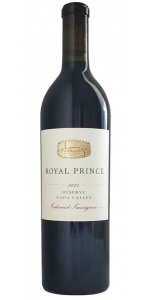Wine from Royal Prince
It’s a crisp winter night in Napa in 2018.
There’s roast chicken in the oven. David Green and Maayan Koschitzky are standing at the counter in David’s kitchen, trying out a sample bottle of the 2016 Royal Prince Pinot Noir before dinner.
“What do you think?” asked David.
“Well, when are you bottling the next one?” said Maayan with a playful smirk.
“Um, well in three months,” said David.
“Good, we’ve got time to fix it.”
With a hearty laugh, the seed of an enduring partnership was planted. David Green, a dynamic wine industry veteran, and Maayan Koschitzky, one of the Napa Valley’s most revered winemakers, would soon join forces.
“You’re hired!” David continued.
“You can’t afford me,” Maayan shot back playfully.
Around this time, Maayan was ramping up his own brand, La Pelle wines, and David was able to make some introductions and use his own industry expertise to help his friend with his brand. It was clear that a synergy was emerging. Soon David would buy out his investors in Royal Prince Wines and invite Maayan to become an equity partner.
“Maayan has all the reasons to be a primadonna, but he’s not,” says David. The duo work so well together, they launched additional brands under the Royal Wine & Spirits umbrella, including Slam Dunk, Ride and Ridden, and Slate. All of the wines met with immediate acclaim.
David Green and Maayan Koschitzky have an enviable rolodex. Between the two of them, they have contacts at hundreds of the best wineries in Napa and Sonoma Counties, and monthly contact with at least 50. This places them at the front of the line for new sourcing opportunities, whether it’s for prime vineyard contracts or a blue-chip winery with five or six more barrels of coveted Cabernet than they know they can sell.
On-Scene, Real-time Knowledge
Maayan’s role as Director of Winemaking for Atelier Melka finds him making the rounds in the vineyards of nearly every AVA in Napa and Sonoma Counties, from the pop of the first Pinot Noir bud in Russian River Valley all the way through the season until the last Cabernet Sauvignon berry is picked on Howell Mountain.
What this means is that he has a running list in his mind of the best-performing AVAs in the North Coast, even before harvest begins. In this way Maayan can focus his energies on the very best-performing sites and “sweet spots” when choosing fruit and wines to buy for the Royal Prince label.
Big, bold and racy, this Cabernet Sauvignon has a dense purple, almost opaque hue and offers up an electrifying bouquet dark red, blue and black fruits with notes of tobacco leaf, graphite and spicy oak. Opulent and layered it flexes its power but is framed by refreshing acidity with silky, sweet tannins. The 2021 displays loads of potential for being enjoyed in its youth, while also rewarding patience over the following decade. For bang for your buck, you can’t find better, or as Robb Report states, “Royal Prince is making the best wines you can buy for your money right now.”
Review:
Made by Maayan Koschitzky (of Atelier Philippe Melka), the 2021 Cabernet Sauvignon Reserve is all varietal brought up in French oak. Its deeper ruby/plum hue is followed by a classic Cabernet Sauvignon nose of cassis and black cherries supported by plenty of sappy herbs, graphite, and obvious minerality. This medium-bodied, lively, elegant Cabernet has ripe, building tannins, a good spine of acidity, and outstanding length. Drink this classic, impeccably made 2021 over the coming 10–12 years, and I wouldn’t be surprised to see it evolve longer. (Jeb Dunnuck)
-Jeb Dunnuck 93+ Points
- back
Selected Options
Wineries
Categories
Pricing
Countries
Regions
Grape Types
Wineries
Organic/Free Shipping
Double Diamond Oakville Proprietary Red is made from 50% Cabernet Sauvignon, 25% Merlot, and 25% Cabernet Franc.
"The inaugural release of the 2021 Proprietary Red Wine upholds the level of excellence expected from winemaker Thomas Rivers Brown. It expresses a fragrant perfume of ripe red cherry, blueberry, and pomegranate, mingled with bell pepper, iron, and vanilla bean. On the palate, generous red and blue fruits are complemented by blackberry compote, dark chocolate, and espresso. The wine has silky tannins, food-friendly acidity, and a lingering finish. It is ready to drink upon release but will cellar well for years to come."
Oumsiyat Assyrtico is made from 100 percent Assyrtico.
Subtle aromas of white fruits and flinty mineral notes are framed by a delicate floral character. Linear on the palate with a wonderfully refreshing and mouthwatering finish.
RS: 2g/L
The grapes were carefully selected to ensure the healthy and ripe fruit was vinified and then gently pressed. The must was racked and cool fermented in stainless steel tanks at controlled temperatures of 14 to 16°C, with selected yeasts. The wine delivers a crisp, fresh style as it did not go through malolactic fermentation. It was lightly filtered prior to bottling.





